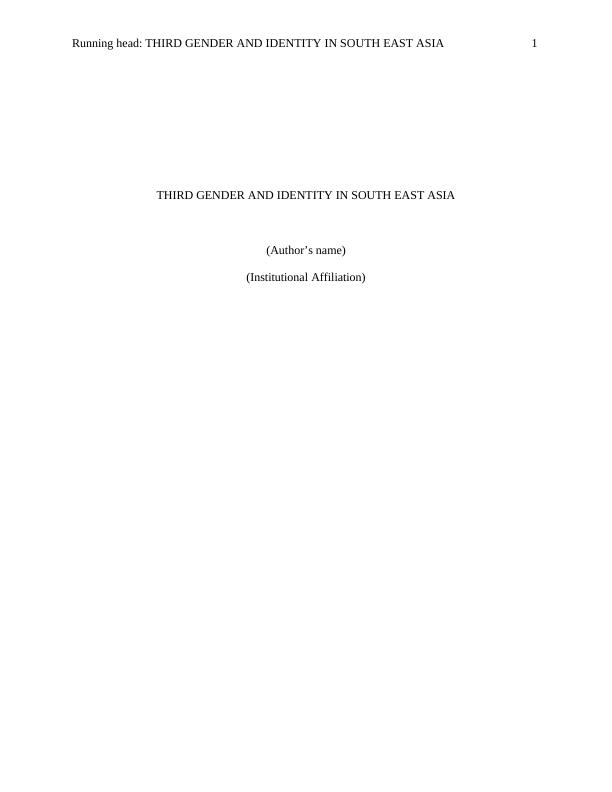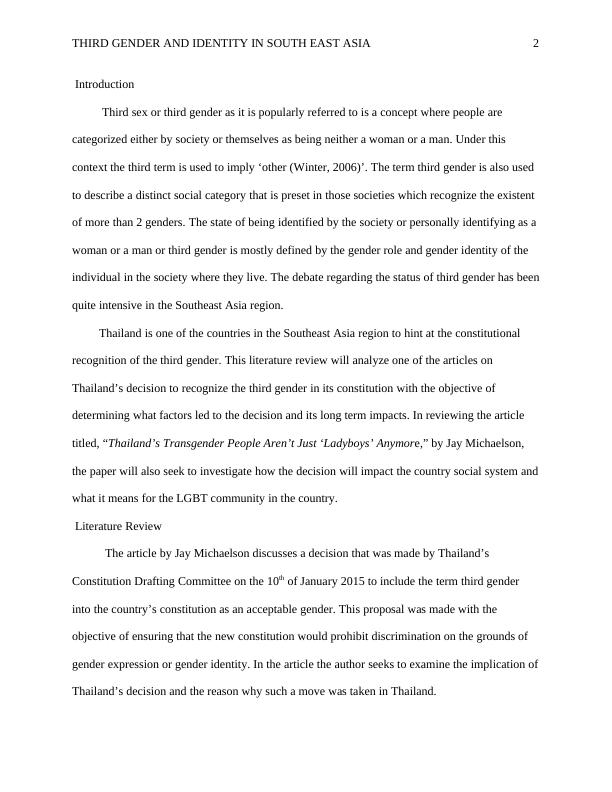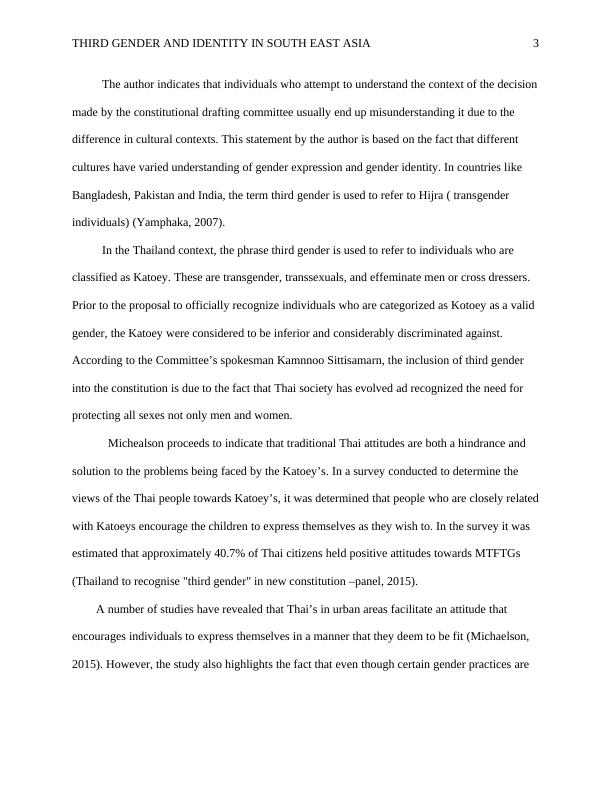Third Gender and Identity in South East Asia Assignment
13 Pages3680 Words73 Views
Added on 2020-03-16
Third Gender and Identity in South East Asia Assignment
Added on 2020-03-16
ShareRelated Documents
Running head: THIRD GENDER AND IDENTITY IN SOUTH EAST ASIA 1
THIRD GENDER AND IDENTITY IN SOUTH EAST ASIA
(Author’s name)
(Institutional Affiliation)
THIRD GENDER AND IDENTITY IN SOUTH EAST ASIA
(Author’s name)
(Institutional Affiliation)

THIRD GENDER AND IDENTITY IN SOUTH EAST ASIA 2
Introduction
Third sex or third gender as it is popularly referred to is a concept where people are
categorized either by society or themselves as being neither a woman or a man. Under this
context the third term is used to imply ‘other (Winter, 2006)’. The term third gender is also used
to describe a distinct social category that is preset in those societies which recognize the existent
of more than 2 genders. The state of being identified by the society or personally identifying as a
woman or a man or third gender is mostly defined by the gender role and gender identity of the
individual in the society where they live. The debate regarding the status of third gender has been
quite intensive in the Southeast Asia region.
Thailand is one of the countries in the Southeast Asia region to hint at the constitutional
recognition of the third gender. This literature review will analyze one of the articles on
Thailand’s decision to recognize the third gender in its constitution with the objective of
determining what factors led to the decision and its long term impacts. In reviewing the article
titled, “Thailand’s Transgender People Aren’t Just ‘Ladyboys’ Anymore,” by Jay Michaelson,
the paper will also seek to investigate how the decision will impact the country social system and
what it means for the LGBT community in the country.
Literature Review
The article by Jay Michaelson discusses a decision that was made by Thailand’s
Constitution Drafting Committee on the 10th of January 2015 to include the term third gender
into the country’s constitution as an acceptable gender. This proposal was made with the
objective of ensuring that the new constitution would prohibit discrimination on the grounds of
gender expression or gender identity. In the article the author seeks to examine the implication of
Thailand’s decision and the reason why such a move was taken in Thailand.
Introduction
Third sex or third gender as it is popularly referred to is a concept where people are
categorized either by society or themselves as being neither a woman or a man. Under this
context the third term is used to imply ‘other (Winter, 2006)’. The term third gender is also used
to describe a distinct social category that is preset in those societies which recognize the existent
of more than 2 genders. The state of being identified by the society or personally identifying as a
woman or a man or third gender is mostly defined by the gender role and gender identity of the
individual in the society where they live. The debate regarding the status of third gender has been
quite intensive in the Southeast Asia region.
Thailand is one of the countries in the Southeast Asia region to hint at the constitutional
recognition of the third gender. This literature review will analyze one of the articles on
Thailand’s decision to recognize the third gender in its constitution with the objective of
determining what factors led to the decision and its long term impacts. In reviewing the article
titled, “Thailand’s Transgender People Aren’t Just ‘Ladyboys’ Anymore,” by Jay Michaelson,
the paper will also seek to investigate how the decision will impact the country social system and
what it means for the LGBT community in the country.
Literature Review
The article by Jay Michaelson discusses a decision that was made by Thailand’s
Constitution Drafting Committee on the 10th of January 2015 to include the term third gender
into the country’s constitution as an acceptable gender. This proposal was made with the
objective of ensuring that the new constitution would prohibit discrimination on the grounds of
gender expression or gender identity. In the article the author seeks to examine the implication of
Thailand’s decision and the reason why such a move was taken in Thailand.

THIRD GENDER AND IDENTITY IN SOUTH EAST ASIA 3
The author indicates that individuals who attempt to understand the context of the decision
made by the constitutional drafting committee usually end up misunderstanding it due to the
difference in cultural contexts. This statement by the author is based on the fact that different
cultures have varied understanding of gender expression and gender identity. In countries like
Bangladesh, Pakistan and India, the term third gender is used to refer to Hijra ( transgender
individuals) (Yamphaka, 2007).
In the Thailand context, the phrase third gender is used to refer to individuals who are
classified as Katoey. These are transgender, transsexuals, and effeminate men or cross dressers.
Prior to the proposal to officially recognize individuals who are categorized as Kotoey as a valid
gender, the Katoey were considered to be inferior and considerably discriminated against.
According to the Committee’s spokesman Kamnnoo Sittisamarn, the inclusion of third gender
into the constitution is due to the fact that Thai society has evolved ad recognized the need for
protecting all sexes not only men and women.
Michealson proceeds to indicate that traditional Thai attitudes are both a hindrance and
solution to the problems being faced by the Katoey’s. In a survey conducted to determine the
views of the Thai people towards Katoey’s, it was determined that people who are closely related
with Katoeys encourage the children to express themselves as they wish to. In the survey it was
estimated that approximately 40.7% of Thai citizens held positive attitudes towards MTFTGs
(Thailand to recognise "third gender" in new constitution –panel, 2015).
A number of studies have revealed that Thai’s in urban areas facilitate an attitude that
encourages individuals to express themselves in a manner that they deem to be fit (Michaelson,
2015). However, the study also highlights the fact that even though certain gender practices are
The author indicates that individuals who attempt to understand the context of the decision
made by the constitutional drafting committee usually end up misunderstanding it due to the
difference in cultural contexts. This statement by the author is based on the fact that different
cultures have varied understanding of gender expression and gender identity. In countries like
Bangladesh, Pakistan and India, the term third gender is used to refer to Hijra ( transgender
individuals) (Yamphaka, 2007).
In the Thailand context, the phrase third gender is used to refer to individuals who are
classified as Katoey. These are transgender, transsexuals, and effeminate men or cross dressers.
Prior to the proposal to officially recognize individuals who are categorized as Kotoey as a valid
gender, the Katoey were considered to be inferior and considerably discriminated against.
According to the Committee’s spokesman Kamnnoo Sittisamarn, the inclusion of third gender
into the constitution is due to the fact that Thai society has evolved ad recognized the need for
protecting all sexes not only men and women.
Michealson proceeds to indicate that traditional Thai attitudes are both a hindrance and
solution to the problems being faced by the Katoey’s. In a survey conducted to determine the
views of the Thai people towards Katoey’s, it was determined that people who are closely related
with Katoeys encourage the children to express themselves as they wish to. In the survey it was
estimated that approximately 40.7% of Thai citizens held positive attitudes towards MTFTGs
(Thailand to recognise "third gender" in new constitution –panel, 2015).
A number of studies have revealed that Thai’s in urban areas facilitate an attitude that
encourages individuals to express themselves in a manner that they deem to be fit (Michaelson,
2015). However, the study also highlights the fact that even though certain gender practices are

THIRD GENDER AND IDENTITY IN SOUTH EAST ASIA 4
socially accepted within Thai culture, official government institutions and a small section of the
society still discriminate against individuals who identify as Katoey.
Thai spiritual beliefs have also played a significant role in shaping Thailand’s traditional
attitudes towards third genders. Unlike western spiritual beliefs where gender is defined based on
the persons anatomy. In traditional Thailand spiritual belief gender is defined based on a
person’s social and sexual role (Bering, 2015). Studies have also revealed that ancient Thai
myths on creation speak of the existence of three genders. These beliefs have led to a majority of
Thailand’s society (especially those individuals in the Northern part of the country) have a
positive attitude towards the concept of third sex.
In his article Michaelson indicates that even though third gender individuals are still
being discriminated against, the move to officially recognize them is a significant step forward.
Their recognition within the constitution is a significant step due to the fact that they too will
enjoy the same social rights that are afforded to members of the male and female genders. The
author proceeds to highlight the fact that as it is the country’s constitution only prohibits
discrimination based on a person’s sex and gender.
This statement serves to highlight the fact that as it currently stands the constitution does
not specifically refer to third gender and therefore it does not protect them. By including the
proposed annex which states that gender includes all gender identities and specifying that gender
does not only refer to the male and female genders but also the phet thi sam ( third gender), the
constitution protects those who fall under this category from being discriminated against.
In the article the author also points out to the loss of the meaning of third gender in its
translation. The author points out to the fact that contrary to popular belief, the term third gender
is a short hand whose contexts has been misrepresented by the media. In the Thai context the
socially accepted within Thai culture, official government institutions and a small section of the
society still discriminate against individuals who identify as Katoey.
Thai spiritual beliefs have also played a significant role in shaping Thailand’s traditional
attitudes towards third genders. Unlike western spiritual beliefs where gender is defined based on
the persons anatomy. In traditional Thailand spiritual belief gender is defined based on a
person’s social and sexual role (Bering, 2015). Studies have also revealed that ancient Thai
myths on creation speak of the existence of three genders. These beliefs have led to a majority of
Thailand’s society (especially those individuals in the Northern part of the country) have a
positive attitude towards the concept of third sex.
In his article Michaelson indicates that even though third gender individuals are still
being discriminated against, the move to officially recognize them is a significant step forward.
Their recognition within the constitution is a significant step due to the fact that they too will
enjoy the same social rights that are afforded to members of the male and female genders. The
author proceeds to highlight the fact that as it is the country’s constitution only prohibits
discrimination based on a person’s sex and gender.
This statement serves to highlight the fact that as it currently stands the constitution does
not specifically refer to third gender and therefore it does not protect them. By including the
proposed annex which states that gender includes all gender identities and specifying that gender
does not only refer to the male and female genders but also the phet thi sam ( third gender), the
constitution protects those who fall under this category from being discriminated against.
In the article the author also points out to the loss of the meaning of third gender in its
translation. The author points out to the fact that contrary to popular belief, the term third gender
is a short hand whose contexts has been misrepresented by the media. In the Thai context the

End of preview
Want to access all the pages? Upload your documents or become a member.
Related Documents
Transgender People: Meaning, Differences, and Rightslg...
|9
|2346
|389
Difference Between Gender and Sexlg...
|5
|1068
|12
Third Gender in Society: Indian Hijras and North American Two Spirit Peoplelg...
|7
|2006
|150
